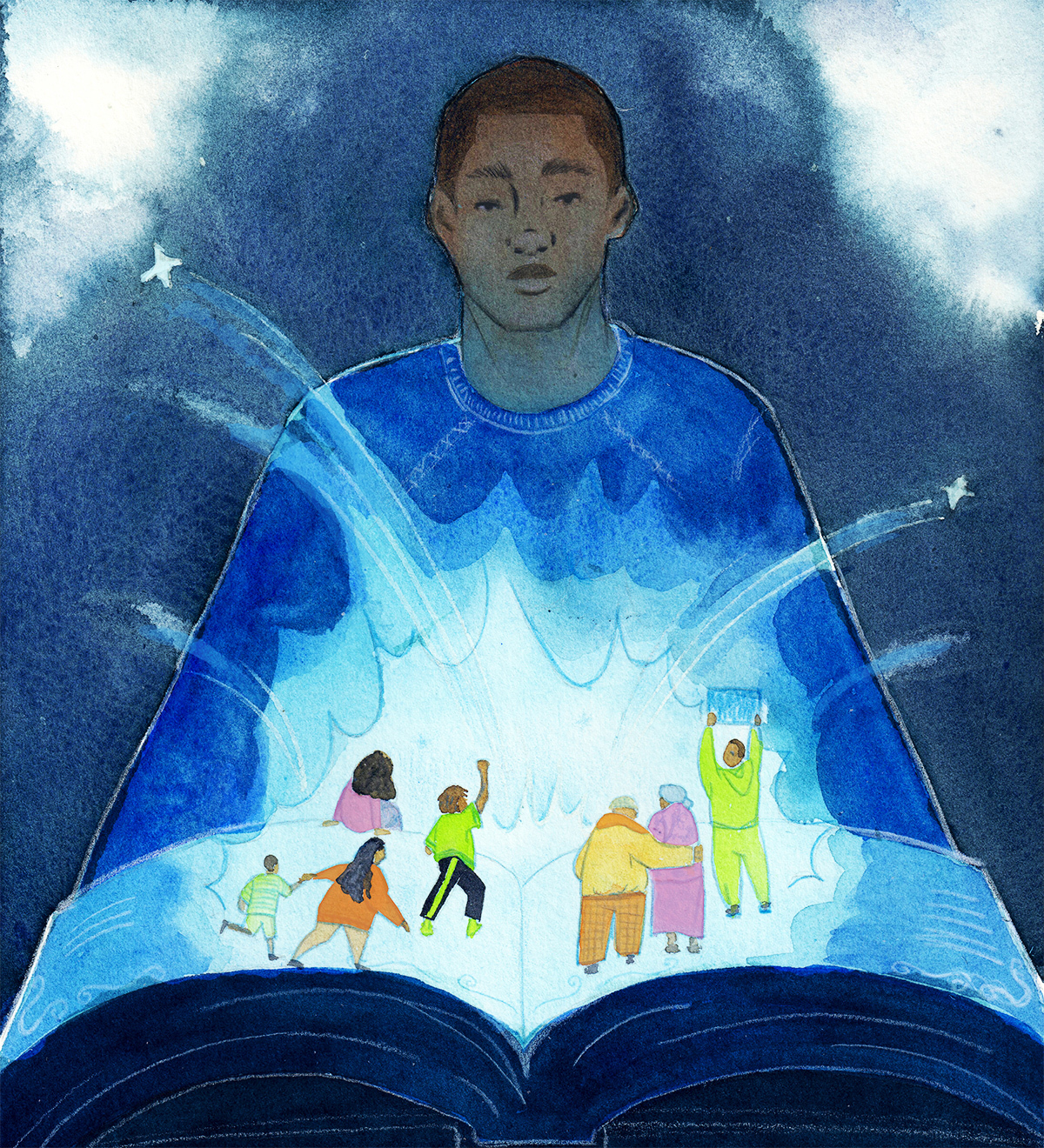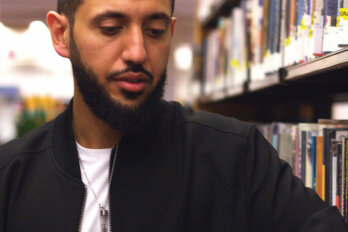One text. Then another. And another.
“I just wanted to check in.”
“How are you doing?”
“Are you safe?”
I wonder: In the wake of escalating displays of anti-Black violence and protest suppression across America, are Canadian friends asking about my physical well-being (because I live in Brooklyn) or my mental well-being (because I am Black)? I offer a similar refrain each time:
I’m okay. To be honest, I’m just happy people aren’t indifferent.
It’s been a particularly bad year for Black people in America—though not only in America. In inordinate numbers, we are dying in the pandemic, unemployed in the recession tied to that pandemic, and denied the financial aid meant to mitigate the effects of that recession, all while billionaires have raked in—or, looted—over $400 billion in increased net worth. America is not, as some are wont to say, falling apart; rather, as Jamelle Bouie explained in a piece he wrote for the New York Times last year, America is working precisely as intended: as a nation that perpetually evolves to preserve white power. The current storm is merely effacing the thin veneer of democracy, justice, and liberty for those who, until now, subscribed to the myth that our so-called free societies are genuinely meritocratic. Many still do.
Then, while already under the immense strain of racial capitalism (that is, how capitalism uses racial logics to justify exploitation), we confronted horrific displays of racial violence. Violence that, as Adam Serwer observes, starkly reminded us of our racial contract. A contract that responds to innocuous “[insert activity] while Black” realities—jogging (Ahmaud Arbery), birding (Christian Cooper), sleeping (Breonna Taylor), shopping (George Floyd)—with gross disproportionality, often death. A contract that turns wellness checks and mental health interventions for women who are Black and/or Indigenous (Regis Korchinski-Paquet and Chantel Moore) into their demise. A contract that kills you for simply being Black and transgender (Tony McDade and Nina Pop). A contract, in other words, that transforms anti-Black mythology into material reality.
In The Alchemy of Race and Rights, Patricia Williams, a legal scholar and foundational thinker in critical race theory, observes how “contract law reduces life to fairy tale”—how, for example, legal contracts are interpreted through simplifying fictions that categorize contract participants on strict binaries of good/evil. The racial contract does the same. But its fairy tale is populated by Black tropes, both historic (Mandingo, Mammy) and modern (Super Predator, Welfare Queen). These characters render historical and contemporary racial inequality not only legible but legitimate; they narrate Black inferiority and, by corollary, white superiority. Simply put: race is a story. And that story self-perpetuates in an infinite cycle: story becomes policy; policy becomes reality; reality becomes story. Wash, rinse, repeat.
Since the story of race first becomes, and then comes from, “reality,” race is bound up in and inextricable from lived experience. And your lived experience differs based on the stories race tells about you and about those around you. In turn, these stories and experiences erect different worlds. Indeed, there is a long tradition of Black thinkers situating themselves apart from the world: “between me and the other world” (W. E. B. Du Bois in 1897); “between the world and me” (Frantz Fanon in 1952); “between that other world and me” (Ta-Nehisi Coates in 2015). Each explored theories for how, as Elizabeth Alexander observed recently, the story of race creates different worlds and, in turn, different world views—what legal scholar Russell Robinson named “perceptual segregation.” For example, in a 2016 survey, whereas 75 percent of white people said that “their local police do an excellent or good job when it comes to using the right amount of force for each situation,” only 33 percent of Black people shared this view. Such views do not—indeed, cannot—reflect one common reality. Rather, they create divergent ones—they tell stories.
Thinking of race as a story can explain why many race scholars tell stories as part of their work. If race is a narrative construction, then stories are simply its constituent parts. And, if the majority narrative is anti-Black, it is understandable for Black scholars to respond with a minority narrative of resistance. In The Alchemy of Race and Rights, Williams—a Black woman—tells one story from 1986, when a white teenager refused her, but not several white people, entry to a Benetton’s store, a refusal that was made possible only because, at that time, shops in New York City were equipped with entry buzzers intended to protect shopkeepers from robbery. This story explains how deference to private interests (a subjective “fear” of robbery) can undermine public obligations (protecting Black people from discrimination). In Perceptual Segregation, Robinson—a Black man—tells a story about an academic conference presentation he gave in 2005, when, in response to an ambiguous paper deadline, the chair of his panel uniquely and publicly rebuked him for submitting his paper late; another panelist who was not rebuked—a white woman—had submitted her paper even later. This story explores how racism can present in circumstances where residual doubt (Was the chair racist or just rude?) leaves room for conflicting interpretations by Black people and white people who observe the same event. And, in The Id, the Ego, and Equal Protection, Charles R. Lawrence III—a Black man—tells a story from 1948, describing the shame he felt, as the only Black child in his kindergarten class, when students laughed while the teacher passed around the racist book Little Black Sambo. This story illustrates the harm of unconscious racism and, in turn, the need to account for such racism in antidiscrimination law.
These authors tell stories from over five decades to provide readers a bridge to their worlds and, thus, to their realities. In telling their stories of race, they untell the story of race.
Many conservative thinkers—most notably Richard Posner—object to storytelling as an approach to discussing race. “By repudiating reasoned argumentation,” he writes, “the storytellers reinforce stereotypes about the intellectual capacities of nonwhites” and self-segregate in “the ghetto of complaint.” But, when race is a story, he is not objecting to how we discuss race—he is misunderstanding race altogether. As Ice-T—a more sophisticated race thinker—once put it: “Don’t hate the player; hate the game.” To not engage with stories is to not speak the language of race.
In any event, race scholars are not alone in telling race stories. Rather, everyone tells stories about race; white supremacy simply disguises anti-Black tales as truths. Indeed, Posner’s critique of storytelling is, quite ironically, replete with fictions he confuses for facts. He lamented, in 1997, how it is not Black people but white people (like himself) who suffer discrimination in law schools; that “socialism” and “poverty law” were failures; and that race scholars exaggerated racism because “the days of lynching” were far behind us. Reminder: Derek Chauvin lynched George Floyd twenty-three years after Posner’s critique. Tall tales, indeed.
These tales-as-truths persist in the conservative imagination to this day and can be seen in the many recent tragedies facing Black people. When COVID-19 hit, conservatives told stories of Black people who caused their own comorbidities, flouted social distancing norms, or had biological predispositions. The conservative objection to storytelling as a means of discussing racial justice is, thus, an objection not to the act of telling stories but to who gets to tell them—who owns the narrative, who owns race itself.
In the absence of Black stories, white stories—in history, cinema, literature, and public discourse—own race. Nixon knew this when he declared a “war on drugs” that was, in reality, a war on Black communities. And Trump knows it now. For that reason, he tells many of today’s race stories. He labels COVID-19 the “Chinese virus” to link the pandemic to a foreign cause rather than to domestic incompetence. He labels Black protesters “looters” and “thugs” and white neo-Nazis “very fine people.” At the end of June, he even tweeted a video of a Trump supporter yelling “white power”—one of the “great people” (his words) who support him. (It has since been deleted.) He is, in other words, deploying race as it always has been: to tell the never-ending story of white supremacy.
Derek Chauvin’s lynching of George Floyd—and its aftermath—reveal that race is mediated through distinct stories of America. In general, debates about police killings and protests “turned” violent (by whom, one might ask) reflect fundamentally different world views. And, in particular, how we respond to George Floyd’s lynching is shaped by how we situate that killing within a broader phenomenon of anti-Black violence, by the story of America we accept. If your world is one afflicted by the odd “bad apple”—an enraging euphemism for the perpetrators of systemic racist police killings—milquetoast police reforms that tinker within the current system may be tempting. But, if your world situates police killings within overlapping social, political, and economic forces sustaining violent white supremacy, then no, modest police reforms won’t do. (Nor will statements of solidarity from, of all places, the National Football League, which, until doing so threatened its bottom line, penalized exceptionally modest statements in support of Black lives, like Colin Kaepernick quietly kneeling during the national anthem.) This performative allyship—which values white money, not Black lives—is audacity and hypocrisy, not solidarity. From sports leagues, it frustrates. From politicians—without legislative change addressing systemic racism and empowering Black communities—it infuriates.
Canada, too, tells stories. As Sean Carleton explains, Heritage Minutes indoctrinate viewers into a mythology of tolerance and multiculturalism. This despite the fact that, as recently revealed by Hal Johnson (a Black man), BodyBreak—the iconic ’90s fitness program Johnson founded with his partner, Joanne McLeod (a white woman)—was rejected by TSN explicitly because it starred an interracial couple. Meanwhile, conservative journalists with national platforms purport to describe “the full story of this country.” Rex Murphy claims that Canada is “in fact not a racist country” while Jon Kay writes that Canadian racism amounts to “cameo appearances” by “a few bigots.” As Vanmala Subramaniam notes, they’ve not done their homework. Far from telling truths about Canada’s past and present, they are simply retelling Canada’s long-standing fictions of pluralism.
But, more importantly, the far too frequent old-white-male refrain questioning the amount of our racism rather than redressing the fact of it reflects Toni Morrison’s timeless words: “The very serious function of racism . . . is distraction.” That is, racism diverts our attention from seeking equality, forcing us to instead expend time and energy on untelling the stories of race that supposedly justify the very inequality we are trying to overcome. Our attention to Quebec’s xenophobic hijab ban is diverted when premier François Legault denies systemic racism; our attention to Ontario’s racial disparities in criminal justice and public health is diverted when premier Doug Ford, though he later retracted it, denies systemic racism; our attention to police brutality—and to the fact that Black Toronto residents are twenty times more likely to be killed by police than are white residents—is diverted when commissioner Brenda Lucki, though she later retracted it, denies systemic racism in the RCMP, or when the House of Commons refuses to acknowledge that racism.
These denials are what Ibram X. Kendi calls “the heartbeat of racism.” Racism must be acknowledged to be fixed; its denial, conversely, ensures its persistence. The New York Times’ 1619 Project challenges the narrative of white innocence in America just as Black and Indigenous writers and activists challenge that narrative in Canada. The story of race creates the reality of racial hierarchy. So counter-stories of race—as Imani Perry calls them, “the everyday poetry of our experience”—are needed for racial equality.
Stories of race across North America are so engrained in our histories we must squint to catch a glimpse of them as stories. America tells a story of freedom. Canada tells a story of multiculturalism. Both mask a reality of racism, colonialism, and imperialism. The profound irony of conservatives claiming to worship facts over feelings is that it is their feelings—on merit, on neutrality, on liberty—that generate the distinct fantasies of exceptionalism in America (“We are great”) and Canada (“We aren’t America”). Indeed, racial fantasy reaches absurdity. Despite clear video evidence of police officer Derek Chauvin killing George Floyd by kneeling on his neck for eight minutes and forty-six seconds—including long after Floyd lost consciousness and pleaded a now familiar phrase of modern American lynchings (“I can’t breathe”)—an initial autopsy linked Floyd’s death to “underlying health conditions” and “potential intoxicants in his system” (in Patricia Williams’ still resonant prose: “a shameful circumlocution”). Worse, the Los Angeles police chief actually called George Floyd’s killing as much the fault of those who protested it as of the officers who committed it. This is not mere belief in America’s race fantasy but unwavering commitment to it—the fetishization of white innocence and Black criminality.
Recent protests across America challenge this fantasy, this American “dream.” When protesters chant, “How do you spell racist? N-Y-P-D,” they tell a different story. And that story demands more than meagre police reform. It demands more than, as Joe Biden suggests, a bullet in the leg instead of in the heart. And it demands more than, of all things, police officers taking a symbolic knee in solidarity with George Floyd when that knee is precisely what ended his life. Rather, the stories that protesters are telling across North America—stories of white supremacy, systemic racism, and justice far too long delayed and thus denied—demand reckoning, revolution, and reparations.
I lied to my friends reaching out from Canada. I am not okay. I am grieving. That’s being honest.
I am grieving for a Black man who died in America. I hesitated, but I ultimately watched the video of George Floyd’s lynching.
And I wept.
I read that, when Floyd cried out for his mother in his final moments on earth—“Mamma! I’m through”—he was calling out not simply to a parent but to one who had died two years prior. Calling not for help but for redemption.
And I wept.
I listened to Floyd’s elementary school teacher describe his childhood aspirations, memorialized in his Black History Month essay from the second grade: “When I grow up, I want to be a Supreme Court judge.” I, too, wanted to be a Supreme Court judge in my youth.
And I wept.
Racked with what Nikole Hannah-Jones describes as the “collective grief” of racial trauma, I wept because, as Ibram X. Kendi observes, “to be black and conscious of anti-black racism is to stare into the mirror of your own extinction.” Reduced to a Black man and nothing but, I feel Floyd’s death as my own.
And so, I am also grieving as a Black man who lives in America. We live in a world constrained by racial scripts. Because, in America’s story of race, there is no Black man, only Black men. With every emerging detail of Floyd’s individuality—of his humanity—I am painfully reminded of how, by telling Floyd’s story—by telling our story—race never lets us tell our own. There is profound sadness in not being able to tell your story. For that reason, as a race scholar, I will continue to tell my story. Because Black individuality—Black stories—that is revolutionary.





